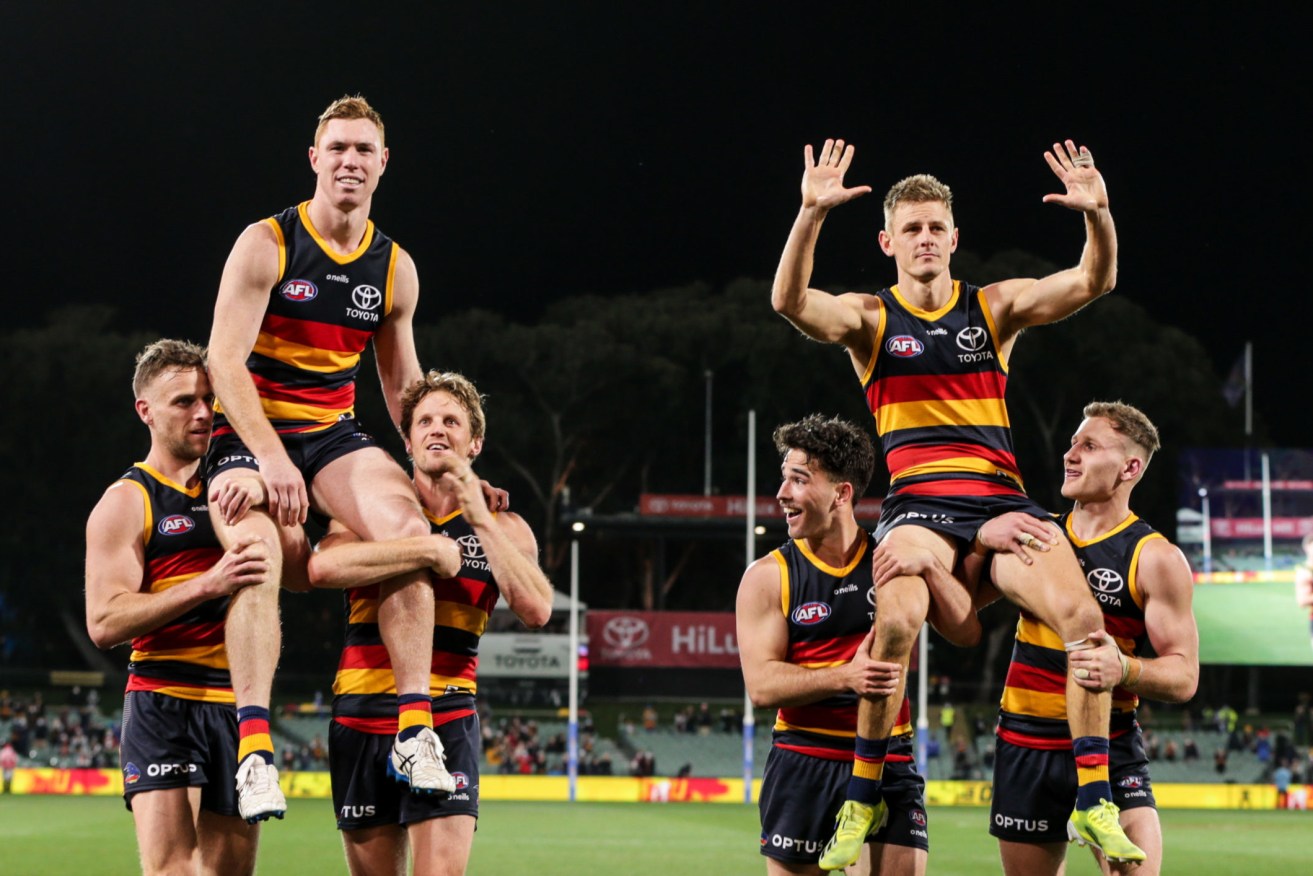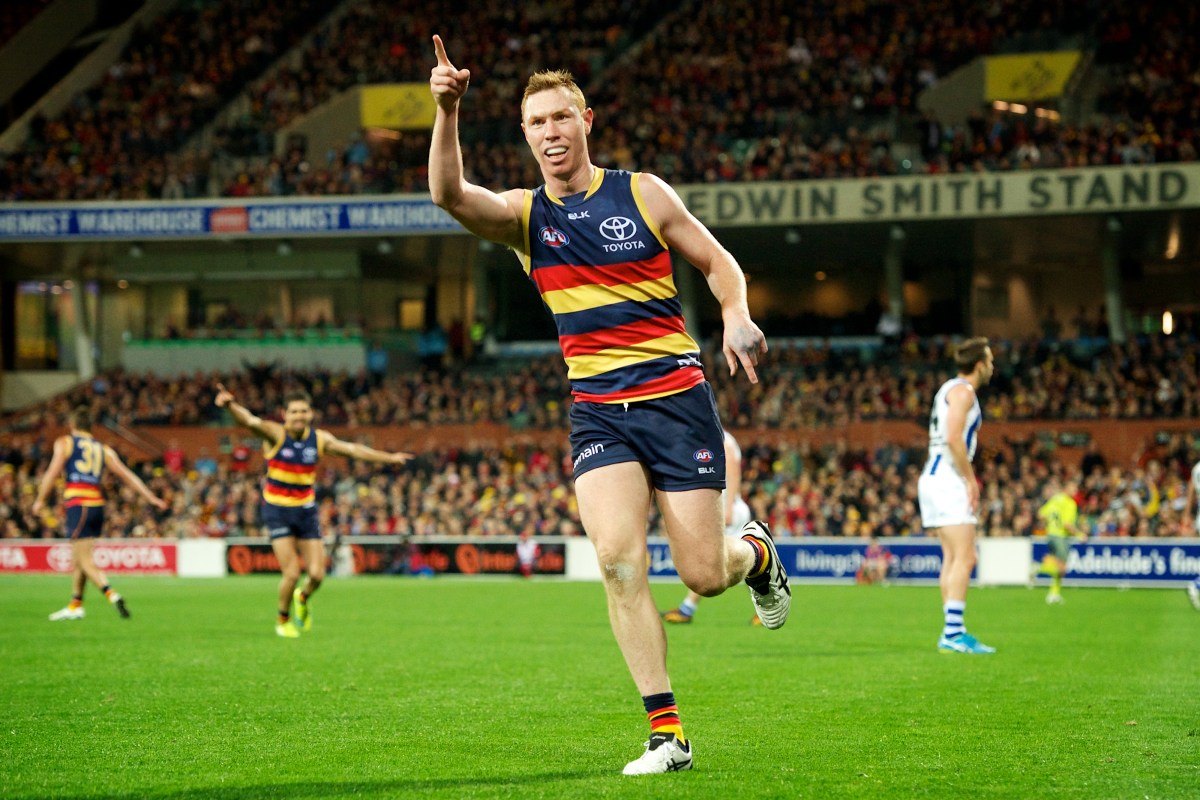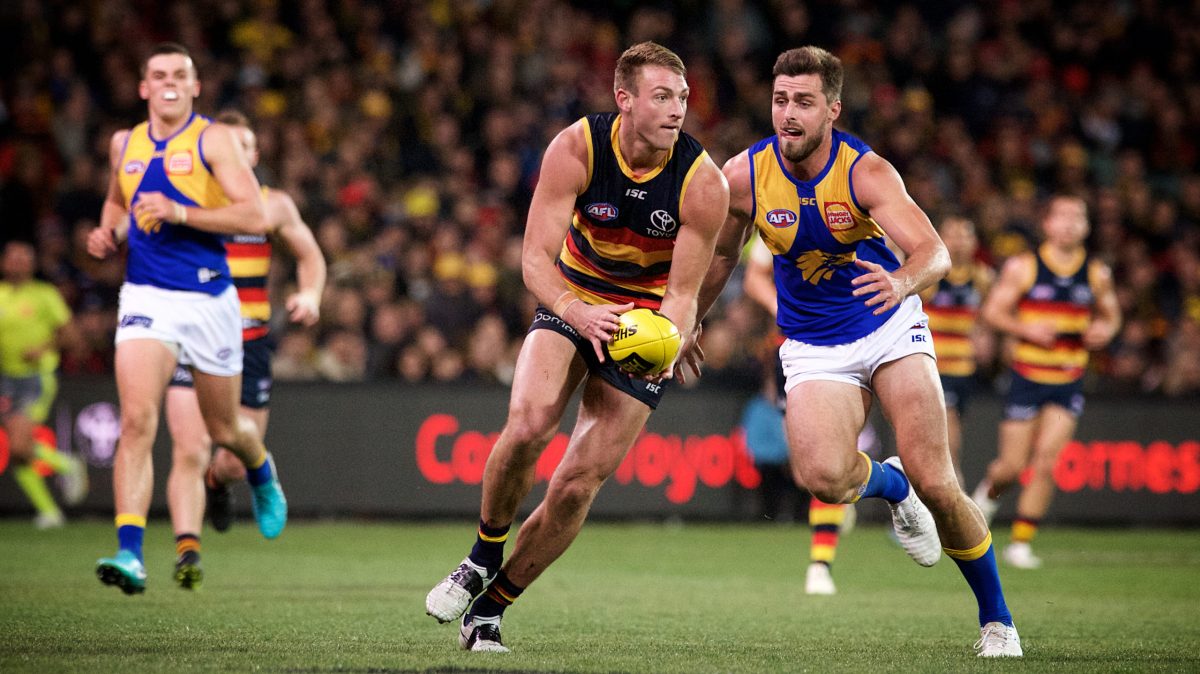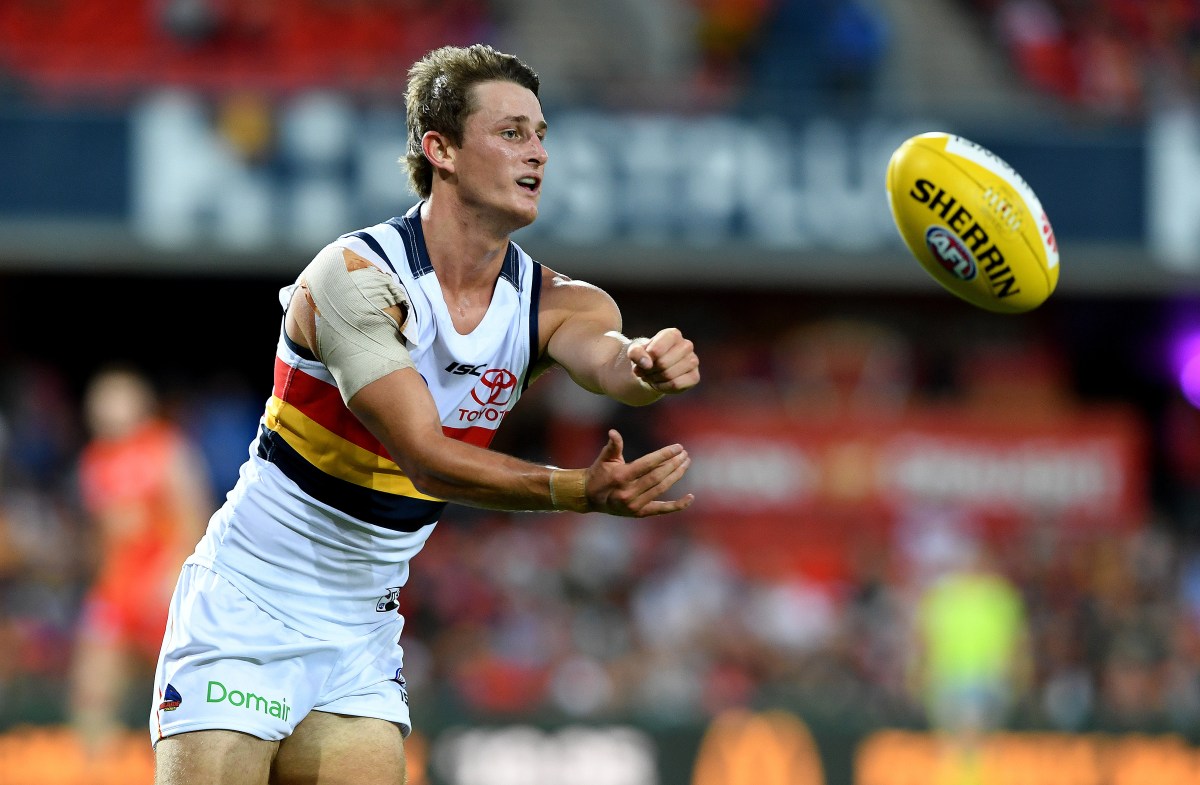Crows rebuild heads back to the future
The Crows are farewelling veteran talent to focus on a youth-led rebuild. It’s an approach the club has used before – on the way to two flags. Can it work again? Michelangelo Rucci reports.

Tom Lynch and David Mackay are chaired off after last weekend's win - their final game for the Crows. Photo:Matt Turner / AAP
At the start of the 2017 AFL grand final, the Crows lined up on the MCG with a collective 2391 games of experience.
The average age of the 22-man line-up was a month short of 26 years. It was an assertive team in the prime of football maturity.
At the start of the 2022 AFL home-and-away season, the Adelaide Football Club’s senior line-up will have an average age of between 21 and 22 years and total national league experience of probably 1300 games. It will be a raw team deep into a rebuild.
This much-watched rebuild is to enter its third year – and is relying on youth more than ever before.
In 1991, the first Crows team that played and thrashed AFL powerhouse and eventual premier Hawthorn at Football Park had a collective count of 211 VFL-AFL matches, with 17 national league debutants. But coach Graham Cornes had mature men, with the average age of the line-up at 26 and loaded with SANFL and State-of-Origin experience.
The best comparison with how far the Crows have changed their squad’s profile, and how close they could be to sustained success, is to look at Adelaide’s first Showdown line-up from April 1997. Just 1251 collective AFL matches, and an average age of 23 years. They lost the first derby, but they won the club’s first AFL premiership five month later.
This was the new-look Crows squad that had experienced men – inaugural captain Chris McDermott, then captain Tony McGuinness, Magarey Medallists Andrew Jarman and Greg Anderson and fan favourite Wayne Weidemann – clear their lockers and remove 600 games of AFL experience from the list before the “Messiah” Malcolm Blight arrived as the club’s third coach.
That clear out, for differing reasons with each player, allowed tyros Andrew McLeod, Simon Goodwin, Mark Ricciuto and Tyson Edwards to become the heartbeat of a new Crows line-up that won two premierships (1997 and 1998) and established a reputation as a league pacesetter through the Neil Craig era from 2005-2011.
Today, history appears to be repeating. The Crows list-management men seem to be dusting down an old file at West Lakes.
Selfless forward Tom Lynch goes after 164 AFL matches and with superb form in his last six matches with the Crows.

Tom Lynch celebrates a goal against the Kangaroos. Photo: Michael Errey / InDaily
All-Australian defender Daniel Talia, who did not play any game this season while the 2014 club champion was cursed with injury, leaves to continue his 200-game career elsewhere, most probably at Richmond. He insists he will pass any medical.

Daniel Talia. Photo: Michael Errey / InDaily
Veteran utility David Mackay passed up a contact for next season, after being worn down by the extra demands imposed on locked-down AFL players following COVID protocols, to end his career at 248 matches.
Free-agent midfielder Matt Crouch, who was tormented by groin issues this season and did not play an AFL match, is expected to find better than the two-year contract offer presented by Adelaide and take his 125 games of experience elsewhere.

Matt Crouch. Photo: AAP/Dave Hunt
And there is still doubt about the future of former captain Taylor Walker, a 13-season player who – if he stays on – will miss the first three matches of next season to serve his ban for a racist comment at an SANFL game.
Experience at West Lakes will be thin. The senior players will be (with most-experienced players named first): Captain Rory Sloane (229 games, aged 31); Walker (220, 31); Brodie Smith (204, 29); Rory Laird (182, 27) and Luke Brown (178, 28).
In a game that has coaches always remind all that “experience cannot be bought”, the Crows are leaving seemingly invaluable experience on the roadside for collection at West Lakes.
And it should be noted how some of the AFL’s current pacesetters, in particular Brisbane, eagerly embrace experience – such as premiership winners Luke Hodge and Grant Birchall from Hawthorn – to guide the development of young players as on-field “playing coaches” and off-field mentors.
Rather than having a team full of talent, I want a team that plays for each other.
“It is about growth, it is about opportunity,” says second-year Adelaide coach Matthew Nicks, mirroring the theme that came for a young crew of Crows players with Blight’s arrival in October 1996. “It is not necessarily we are looking to move on experience; we want to keep a balance.
“We definitely don’t want to go down the path of going too young. That is what we are working through at list management. We are looking at what time will do, how can we improve quickly, how do we develop our group fast because we want to get back to competing for finals football.”
Such heavy pruning, not seen at Adelaide since the bloody spring of 1996, will leave the list-management strategy being engineered by board member Mark Ricciuto, list manager Justin Reid and recruiting manager Hamish Ogilvie up for strong public debate for a long time.
Asked to sum up the strategy in one word, Blight told InDaily: “May I have two? Hardly understandable.”
Blight is not alone. Many have questioned why, when experience is invaluable for mentoring young squads, the Crows would move on Lynch and Talia while they both have so much to contribute on and off the field – in particular Lynch, who has been a spiritual leader. He not only is “The Connector” of team play in the forward half of the field, but also of his team-mates in the clubhouse.
Former Crows defender-midfielder Bryce Gibbs, the man of the “expensive” trade with Carlton after the 1997 grand final loss, remains just as bewildered by Adelaide’s heavy hand at list management.
“It was an unusual one from my point of view; you still need a bit of a balance (with youth and experience),” said Gibbs, now an SANFL player with South Adelaide. “Adelaide already has one of the AFL’s youngest lists.
“You need good senior players around to help develop, fast-track the young kids.
“The Crows list-management team obviously have their strategy in place. But I would not be getting rid of all senior heads, especially if they can still contribute on a Saturday afternoon, which Tom Lynch and Daniel Talia can still do.”
Adelaide finished the home-and away season with seven wins and 17 losses and ranked 15th of 18 – the club’s worst result in a 22-round qualifying series (after finishing 14th of 17 with a 7-15 win-loss count in 2011 when coach Neil Craig resigned late in the season).
The Crows have missed a club-record four consecutive final series, while ranking 12th in 2018 then 11th, last and 15th with a 32-51 win-loss count.
Adelaide certainly has advanced from the wooden spoon collected with just three wins from 17 in last year’s COVID-shortened season. While the Crows remain a bottom-four team with much ground to make up, Nicks is working a better football program. His coaching panel was significantly strengthened with the gains of Scott Burns as the senior assistant and the return of former captain Nathan van Berlo to manage the midfield.
The so-called DNA of Crows football became, to quote Nicks, built on a team characterised by its “love to compete, love to fight”.
“We have improved,” insists Nicks. “We are more consistent. We have found a game plan that we have complete clarity as a full squad. There are a lot of younger guys still learning how to perform week in, week out but we are confident we are heading in the right direction.”
The comparison with the 1996 clear-out that gave opportunity to McLeod, Goodwin, Ricciuto, Edwards and Kane Johnson is today repeating with, by Nicks’ nominations, midfielder Harry Schoenberg, key defender Jordan Butts, key forward Riley Thilthorpe and the much-debated Chayce Jones who moved out of the midfield (where he struggled to find the ball) to rebuild hope at half-back.
But even with this progress the biggest question is how Adelaide – after so many errors at the trade table and draft recently – will, to quote Nicks, find new blood to establish “sustained success”.
There is no phantom draft guide that deals with Nicks’ key demand for recruits who have “character – team first, prioritise others”.
“Rather than having a team full of talent, I want a team that plays for each other,” he says.
This remark might draw greater focus when paired with Talia’s observations on where Adelaide still needs to do much work; that mysterious theme of “culture”.
“The club does need to be aggressive (in the list rebuild),” says Talia, adding this approach is forced not just by the AFL system of dragging down successful teams with the salary cap and late draft picks, but also the mistakes Adelaide made in earlier list-management calls.
“But I am not as rosy as all the supporters are (on finals being within reach next season). I still think the club, behind the scenes, has a lot to work on in terms of their cultural stuff and some of the things that have gone on … I won’t go into details, but it is an interesting one.
“They are being really aggressive (with the rebuild) and whether that is the right call or not we will find out over the next few years. I still think the club has a fair way to go if they want to be successful and really challenge for a flag in a couple of years.
“I know behind the scenes the guys are working really hard on those issues. Let’s hope they can get there.”
Even Nicks repeatedly used the “culture” theme in response to questions about Adelaide’s much-analysed agenda in the upcoming trade market in October and national draft in November.
We are here to build long-term culture, sustained success.
“List management … sometimes it is not as clear cut as what you think in the first 12-24 months of a player arriving at a football club. There are things you are working through, it is not just about the individual but setting the culture at the football club,” Nick said. “What is expected of you in your role in the side.
“We had all 44 players learning that last year. One example is (wingman) Paul Seedsman. He has played a lot more football than most of our group. It took Paul 12 months to understand what I would like our culture and DNA to look like. To his credit, he was outstanding this season (and has earned an All-Australian nomination).
“He has bought into that (culture) and become one of the best leaders at the football club.”
Many have misread Talia’s remark as a bitter crack at the club that has dumped him, more so when he is passing up the invitation to attend the club champion count. But Talia – like Lynch – is an independent thinker who is never scared to express his views for the betterment of the team and club.
“I have always been very vocal behind the scenes because I wanted the best for the organisation,” said Talia admitting he no longer needs to be “delicate” in his public assessments of the Crows.
“I want to see the club, the young guys there, my mates succeed.
“I want that environment be the best it can be. I am really passionate about that.”
Talia was just 23 when he won the Malcolm Blight Medal as club champion and delivered a landmark speech demanding better at West Lakes by saying: “We’re always saying we’re nearly there, nearly there … but now is the time for action more than words.
“We have to change something in the pre-season. We need more guys being consistent and having consistent years. In the past couple of years too much has been left to the top six to eight guys – the leadership group really has been carrying the rest of the group.
“But we can’t talk about it. We have to do it.”
Talia leaves the club at age 29 still waiting for the Crows to do more, not just on the field but also in the clubhouse where the new leadership team of chairman John Olsen and chief executive Tim Silvers has a full agenda.
They need to manage tight budgets while continuing to invest in the football program. The impending arrival of fitness master Darren Burgess from Melbourne and strategy guru Neil Balme from Richmond will enhance Nicks’ chances of lifting Adelaide back to the AFL top eight and finals for the first time since the 2017 grand final.
“We are building a strong group of people; staff, not just players,” Nicks said. “We are here to build long-term culture, sustained success.”
Off field, there is the key agenda item of a new home away from a West Lakes – either Thebarton Oval or Brompton. The old gas works at Brompton allow the Crows to be masters in their own domain whereas Thebarton require sharing with the SANFL and Adelaide Footy League. But would money – that is tight – be better spent at Thebarton than in digging up polluted soil at Brompton?
Despite reports declaring the Crows have chosen Brompton as the preferred site, Olsen says “due diligence” continues in studying both sites – and this process might need another month or two.
And there is the Walker dilemma, a most-difficult challenge that is further complicated by a petition from Crows fans demanding the club’s greatest goalkicker play on or they will tear up their membership tickets.
It has not been so demanding of Adelaide since 1996 when the club had failed to played in finals three consecutive years and was losing its monopoly hold on the South Australian market with the rise of Port Adelaide from the SANFL.
But a year later – after ruthless calls on list management, including the sacking of the team captain – the Crows had their first AFL premiership. It is a script many Crows fans would hope is repeated 25 years later.




